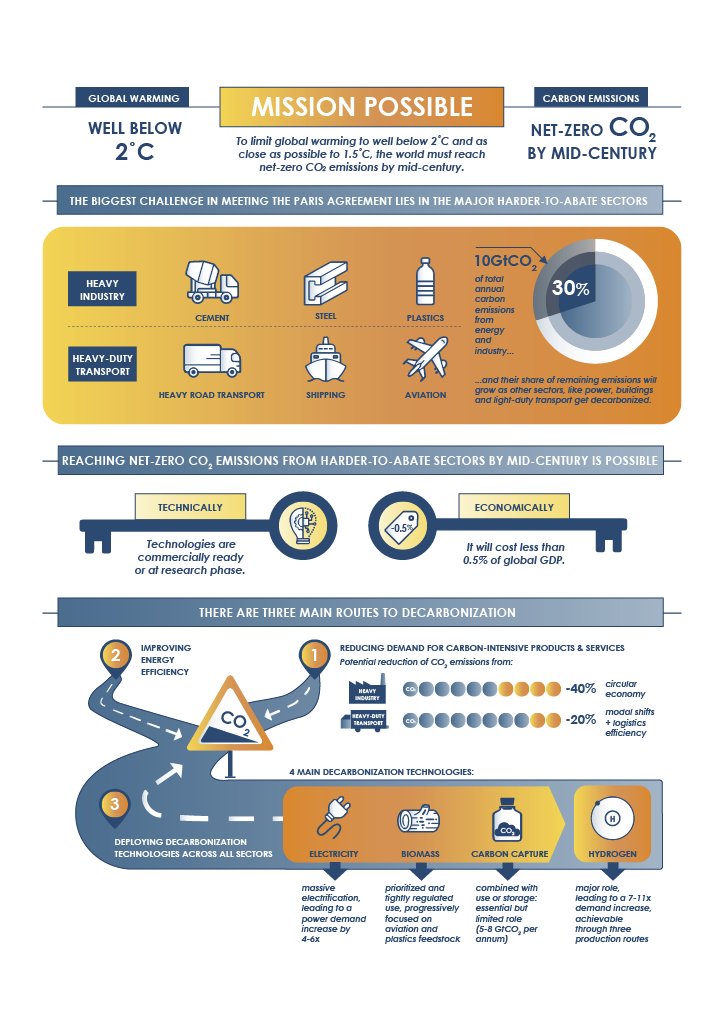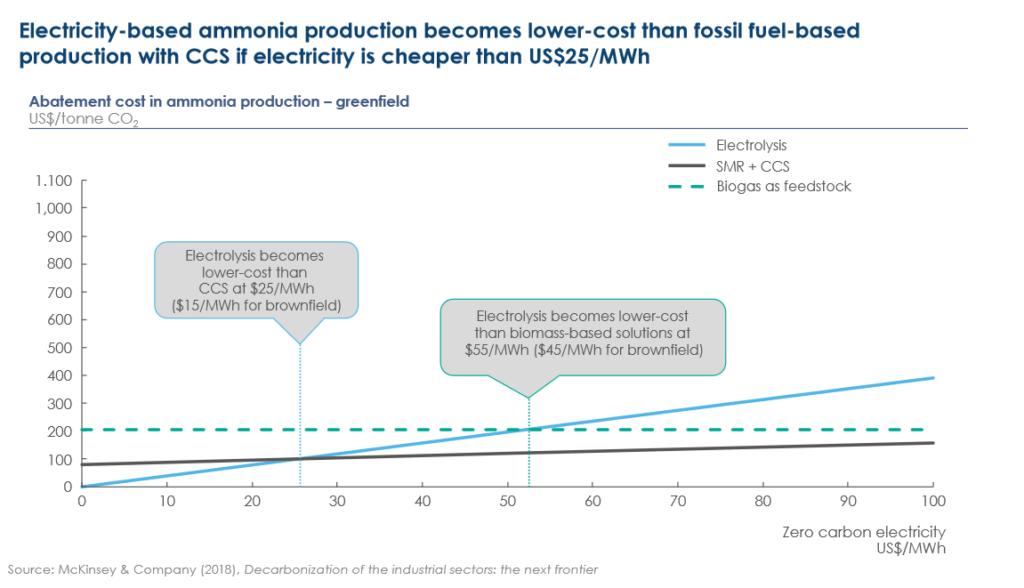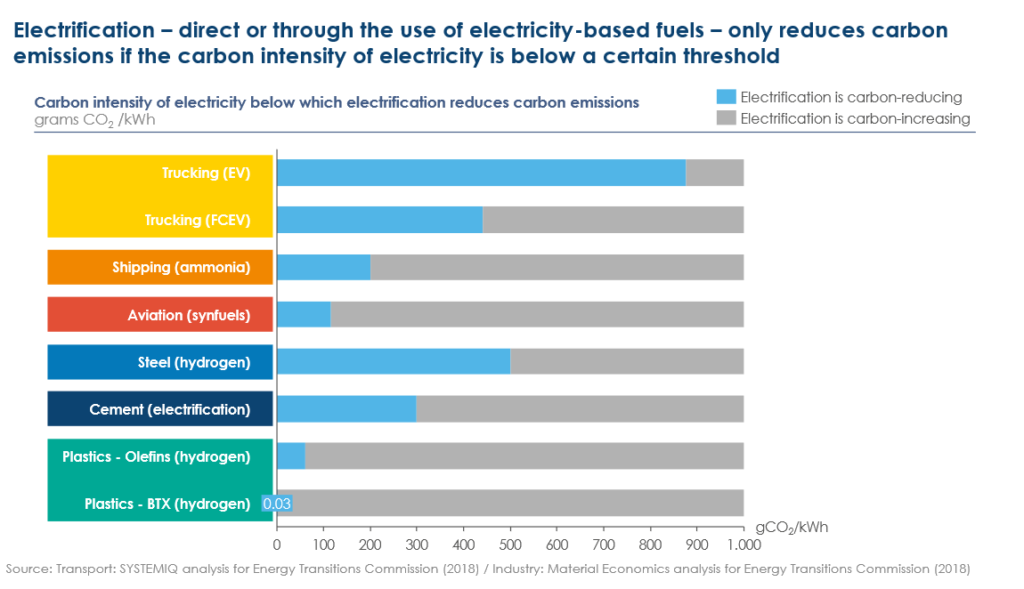Mission Possible: decarbonizing ammonia
By Trevor Brown on January 18, 2019
Mission Possible, a major report published at the end of 2018, concludes that decarbonizing ammonia production by 2050 is both technically and economically feasible. Among its 172 pages of assumptions, analysis, and explanation, Mission Possible examines production pathways and markets for green ammonia and its derivative green nitrogen fertilizers. It addresses the relatively straightforward issue of how to replace fossil feed stocks with renewable hydrogen for ammonia synthesis, as well as the more complex question of how to source or supplant the carbon dioxide molecules contained in urea, the most common nitrogen fertilizer.
The report’s economic conclusions will not surprise anyone involved in ammonia production or politics. Yes, green ammonia is currently more expensive than fossil ammonia, although it won’t be for long. And no, “none of the increases in end-consumer prices are sufficiently large to be an argument against forceful policies to drive decarbonization.”
The report was published by the Energy Transitions Commission (“a coalition of business, finance and civil society leaders from across the spectrum of energy producing and using industries”), and Mission Possible describes itself as “a clear signal to policymakers, investors and businesses: full decarbonization is possible, making ambitious climate objectives achievable.”

Mission Possible examines the “hard to abate” sectors: heavy industry (specifically cement, steel, and plastics) and heavy-duty transport (road freight, shipping, and aviation). Ammonia is central to the mission to reduce emissions in these sectors because of its potential as an energy carrier, entering new markets as a carbon-free fuel, energy storage medium, and transportation vector for hydrogen. I wrote about these energy applications for ammonia last week, reporting how Mission Possible concludes that “International trade in hydrogen or ammonia is likely to play a key role” in enabling economies to decarbonize.
However, for ammonia to have any impact on decarbonization, it must be produced without carbon dioxide emissions.
Apart from plastics, ammonia is the most important chemical in terms of energy use and CO2 emissions … moreover, the use of ammonia is likely to grow significantly, with major potential application as a shipping fuel and as an energy carrier on an international scale. It is therefore essential to cut the emissions resulting from ammonia production and use.
Energy Transitions Commission, Mission Possible, November 2018
Decarbonizing Ammonia
Mission Possible identifies only two viable technology options for decarbonizing ammonia (other than biomass, which is plays only a minor role due to resource constraints).
First, producers could continue using natural gas as a feed stock (SMR) but add carbon capture and storage (CCS) technology. This would need to capture the CO2 from both the process gas (roughly 66% of the CO2 emissions) and also the combustion emissions (roughly 34%). If the plant was partially electrified, those combustion emissions could be eliminated but, even then, leaks and system losses would negatively affect the decarbonization potential of CCS.
The CO2 stream produced in the SMR process is twofold. The process CO2 stream is relatively pure, therefore capture costs are minimal. In most ammonia plants, these concentrated flows are already captured and used for urea … The remaining emissions relate to natural gas combustion and are more diluted and costlier to capture. The cost-competitiveness of SMR plus carbon capture will therefore depend on how much of the CO2 streams is actually captured and on whether the heat input can be electrified (rather than produced by combustion of gas). In the best case scenario, in any case, the SMR route would only be a close-to-zero-carbon solution, given 10-20% of leakage in the capture process.
Energy Transitions Commission, Mission Possible, November 2018
Second, ammonia producers could swap fossil fuels for water as their source of hydrogen, and replace the SMR units with electrolyzers.
Electrolysis … could become the dominant production route. The cost will depend on the cost of zero-carbon electricity and on the capital cost of electrolysis … both these costs are likely to fall significantly over time, particularly in regions with favorable wind and solar resources.
The optimal route forward to reach net-zero CO2 emissions from ammonia production will therefore vary by region in the light of natural resource availability and electricity prices [Exhibit 2.10]. But, by one route or another, it will be possible to decarbonize ammonia production at a relatively low cost of US$80/tCO2 saved or lower.
Energy Transitions Commission, Mission Possible, November 2018
The report identifies the price thresholds at which each carbon abatement technology becomes competitive. According to its analysis, electrolysis offers a cheaper route to decarbonization than “biomass-based solutions” when carbon-free electricity prices drop to $55/MWh for new plants or $45/MWh for existing plants (brownfields); electrolysis then becomes cheaper than CCS at an electricity price below $25/MWh for new plants or $15/MWh for existing ones.

For reference, this CO2 abatement cost of $80 per ton of CO2 relates to an increase in ammonia production cost of around $160 per ton of ammonia, assuming roughly 2 tons of CO2 are emitted per ton of ammonia. To understand the true economic impact of decarbonization, the report identifies the true end product, and concludes that “None of the increases in end-consumer prices are sufficiently large to be an argument against forceful policies to drive decarbonization.”
If investments are being made for the purposes of decarbonization, there is very limited potential for fossil-based CCS to be deployed in ammonia plants, due to the technology’s limited ability to eliminate CO2 emissions. Mission Possible identifies an acceptable mid-century ratio of renewable to fossil inputs, which is valid for both electricity generation and ammonia production: decarbonization can be achieved with 85-90% renewable (or nuclear) inputs, and only 10-15% fossil-CCS inputs.
Total electricity generation, whether for direct use, or for the production of hydrogen, ammonia or synthetic fuels, will need to grow from around 20,000TWh today to 85-115,000TWh by mid-century. This hugely increased electricity supply will have to be produced at 85-90% from direct zero-carbon electricity generation (i.e. renewables or nuclear) with only 10-15% coming from biomass or abated fossil fuel inputs.
Energy Transitions Commission, Mission Possible, November 2018
Decarbonizing nitrogen fertilizers (What about urea?)
A big challenge with abating emissions in the fertilizer production process is that most ammonia plants already utilize those CO2 emissions to produce urea. Mission Possible confronts this issue of “embedded carbon” as well.
Beyond decarbonizing the chemicals production processes, the key challenge to fully decarbonize the chemicals industry, taking into account the lifecycle of its products, is to address the embedded carbon, which is released at point of use for fuels and N-fertilizers, and at end-of-life for plastics. There are two routes that can enable this:
- Biochemistry, which can be zero-carbon over its lifecycle provided that all feed stock and energy inputs to the biomass production and refinery process are zero-carbon, and that it doesn’t create indirect carbon emissions from land use change
- Synthetic chemistry, which can be zero-carbon over its lifecycle provided the electricity input is zero-carbon and the CO2 input comes from direct air capture.
… Elimination of these CO2 emissions will therefore require either:
- A move away from urea-based to other (e.g. nitrate-based) fertilizers;
- Use of biogas as the input to a SMR process, from which CO2 is then
captured and used in the production of urea-based fertilizers; - The use of CO2 directly captured from the air (DAC) combined with
zero-carbon ammonia.
Energy Transitions Commission, Mission Possible, November 2018
For reference, the report cites a potential future price for DAC CO2, saying that “direct air capture of CO2 could cost less than US$100/tCO2.” Relative to today’s urea market price of around $300 per ton, and given that the production process consumes roughly 0.75 tons of CO2 per ton of urea, the price impact of switching to carbon-neutral urea would therefore be a roughly 25% increase. (In fact, it would be less than this, because of additional cost-savings relative to the current process, due to the fact that existing CO2 capture, compression, and storage equipment would become redundant).
Not all electricity is equal
As anybody familiar with arguments against electric cars will be aware, electrification does not always deliver immediate emission reductions, because using grid electricity (indirect fossil fuels) can often be more carbon intensive than using fossil fuels directly. Thus, Mission Possible warns, “the optimal and feasible pace of electrification should therefore be carefully thought through.”
If applications are electrified before electricity supply is decarbonized, the immediate impact can be an increase in emissions. Our analysis suggests, however, that … it is unlikely to place a limit on the appropriate pace of decarbonization of the industrial and heavy-duty transport sectors considered in this report.
The crucial question is, how low the carbon intensity of electricity (measured in grams of CO2 per kWh) needs to be in order for electrification (direct or via electricity-based fuels) to produce a reduction in emissions [Exhibit 7.3] …
In shipping, the use of ammonia (produced from hydrogen from electrolysis) will be carbon-reducing if the electricity used is below 200g/kWh …
Even in China and India, however, carbon intensities could fall below the direct electrification breakeven point of 875gCO2/kWh by 2030, with electric mobility then generating emissions reductions. Hydrogen and ammonia-based solutions could be carbon-reducing by 2040 to 2050, and even earlier if hydrogen production facilities were placed to utilize zero-carbon electricity.
Energy Transitions Commission, Mission Possible, November 2018
The responsibilities of trade associations

The final chapter of Mission Possible, “Driving progress through private sector action,” identifies responsibilities for three groups: trade associations, producers, and buyers. As the report says, “market forces alone will not drive progress, but they can and should plan for it.” While the responsibilities it identifies for producers and buyers are insightful, its view of the contributions that trade associations must start to make is noteworthy.
Mission Possible identifies four specific actions that trade associations and industry initiatives should begin with urgency.
First, trade associations should “Develop roadmaps to net-zero carbon emissions by mid-century.”
Second, industry groups should “Develop cross-sectoral initiatives, bringing together producers and buyers,” which could “Develop low/zero-carbon labels” and, beyond marketing, could “Create a demand for low/zero-carbon products” directly – for example, by making long-term purchasing commitments.
Third, “Develop early-stage innovation funds.”
Finally, it is essential for industry associations to align corporate lobbying with the net-zero-carbon-emissions agenda, by not opposing and preferably actively using their lobbying capacity to support a set of policies (including carbon prices and regulations) which are necessary to drive progress in their sectors.
Energy Transitions Commission, Mission Possible, November 2018
You can also read the full article at AmmoniaIndustry.com.